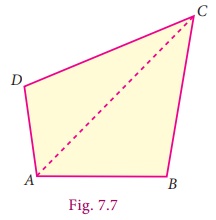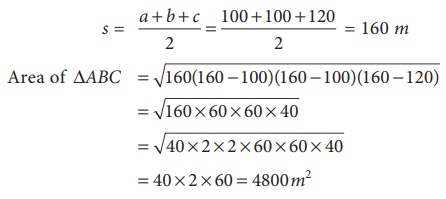Chapter: 9th Maths : UNIT 7 : Mensuration
Application of HeronŌĆÖs Formula in Finding Areas of Quadrilaterals
Application of HeronŌĆÖs Formula in Finding Areas
of Quadrilaterals
A plane figure
bounded by four line segments is called a quadrilateral.

Let ABCD
be a quadrilateral. To find the area of a quadrilateral, we divide the quadrilateral
into two triangular parts and use HeronŌĆÖs formula to calculate the area of the triangular
parts.
In Fig 7.7,
Area of quadrilateral
ABCD = Area of triangle ABC + Area of triangle ACD
Example 7.3
A farmer
has a field in the shape of a rhombus. The perimeter of the field is 400m
and one of its diagonal is 120m. He wants to divide the field into two equal
parts to grow two different types of vegetables. Find the area of the field.
Solution
Let ABCD
be the rhombus.
Its perimeter
= 4 ├Ś side = 400 m
Therefore,
each side of the rhombus = 100 m
Given the
length of the diagonal AC = 120 m
In ŌłåABC, let a =100 m, b =100 m,
c =120 m

s = (a
+ b + c) / 2 = (100 +100 +120) / 2 = 160 m
Area of ╬öABC = ŌłÜ [160(160 ŌłÆ100)(160 ŌłÆ100)(160 ŌłÆ120)]
= ŌłÜ [160├Ś60├Ś60├Ś40]
= ŌłÜ [40├Ś2├Ś2├Ś60├Ś60├Ś40]
= 40 ├Ś
2 ├Ś
60 =
4800m2
Therefore,
Area of the field ABCD = 2 ├Ś Area of ABC = 2 ├Ś 4800 = 9600 m2
Related Topics